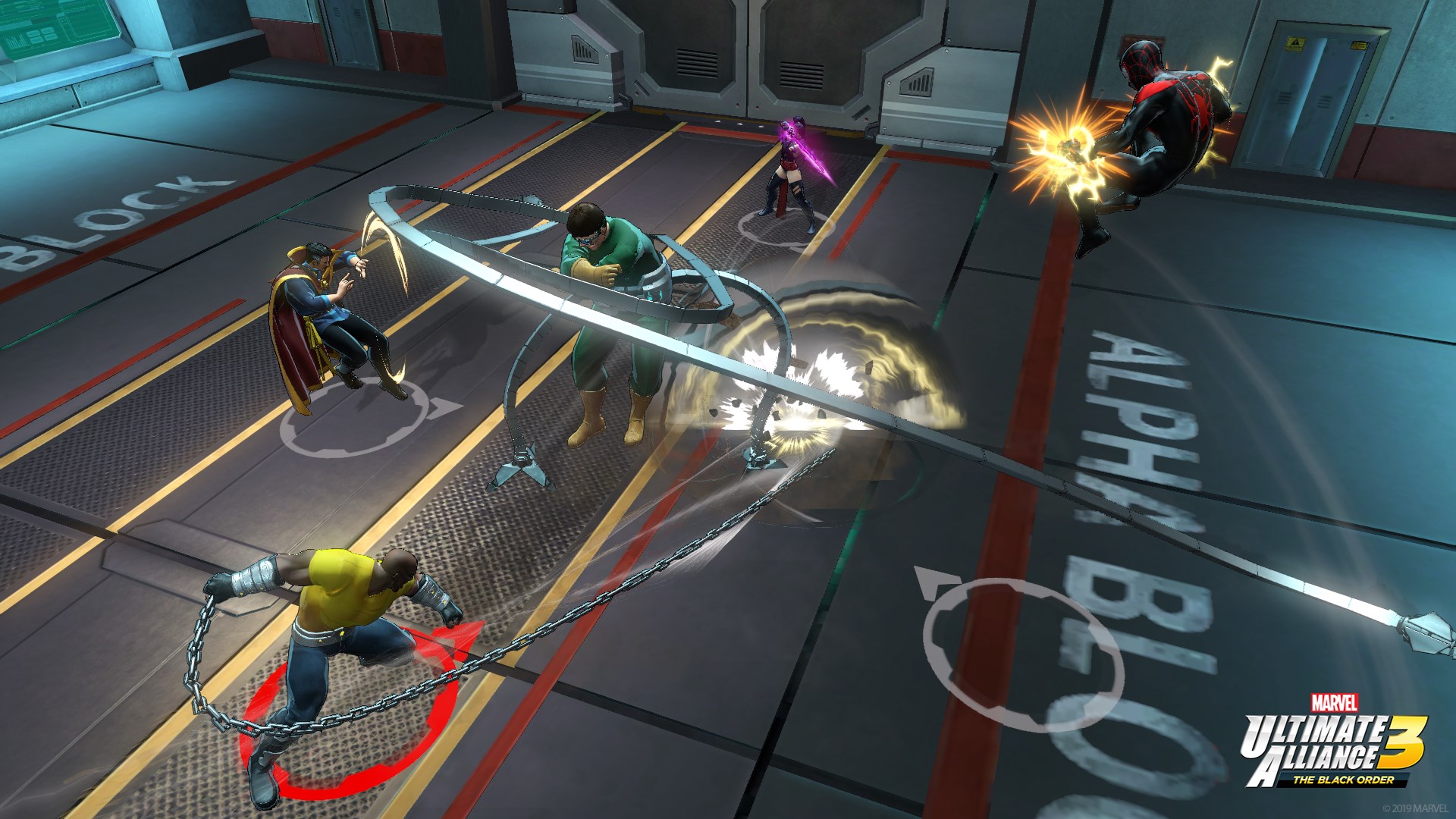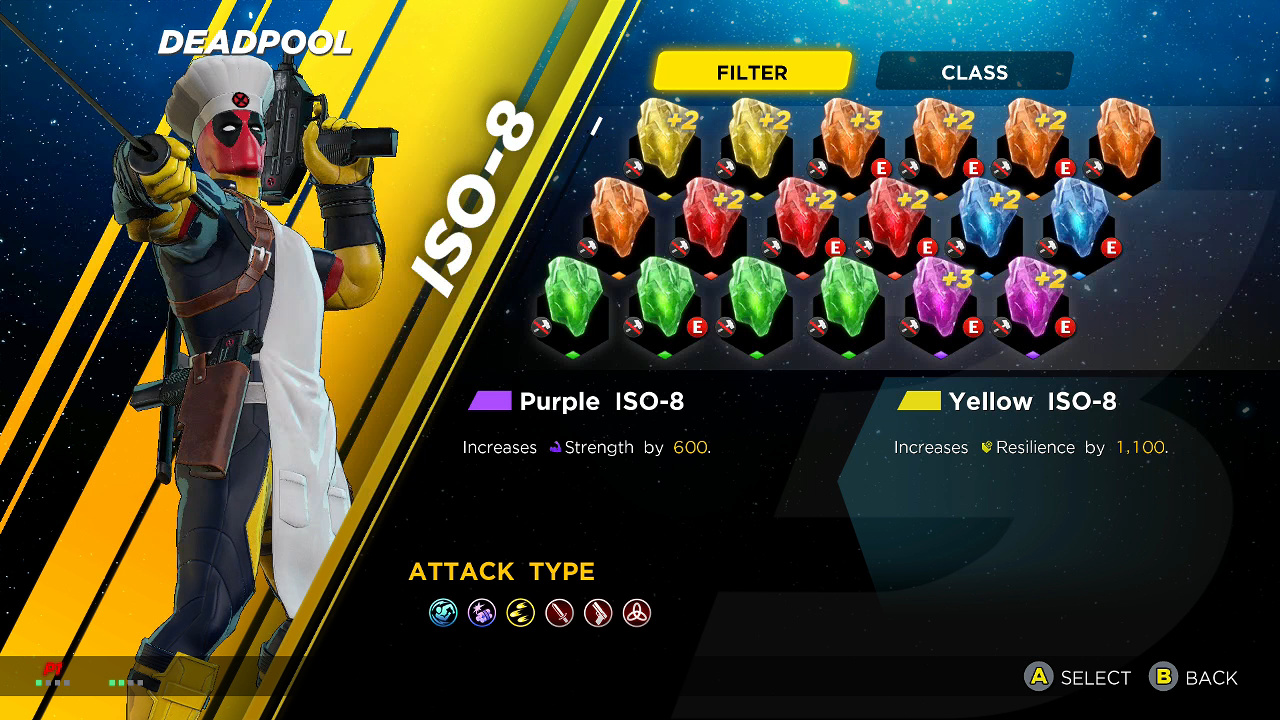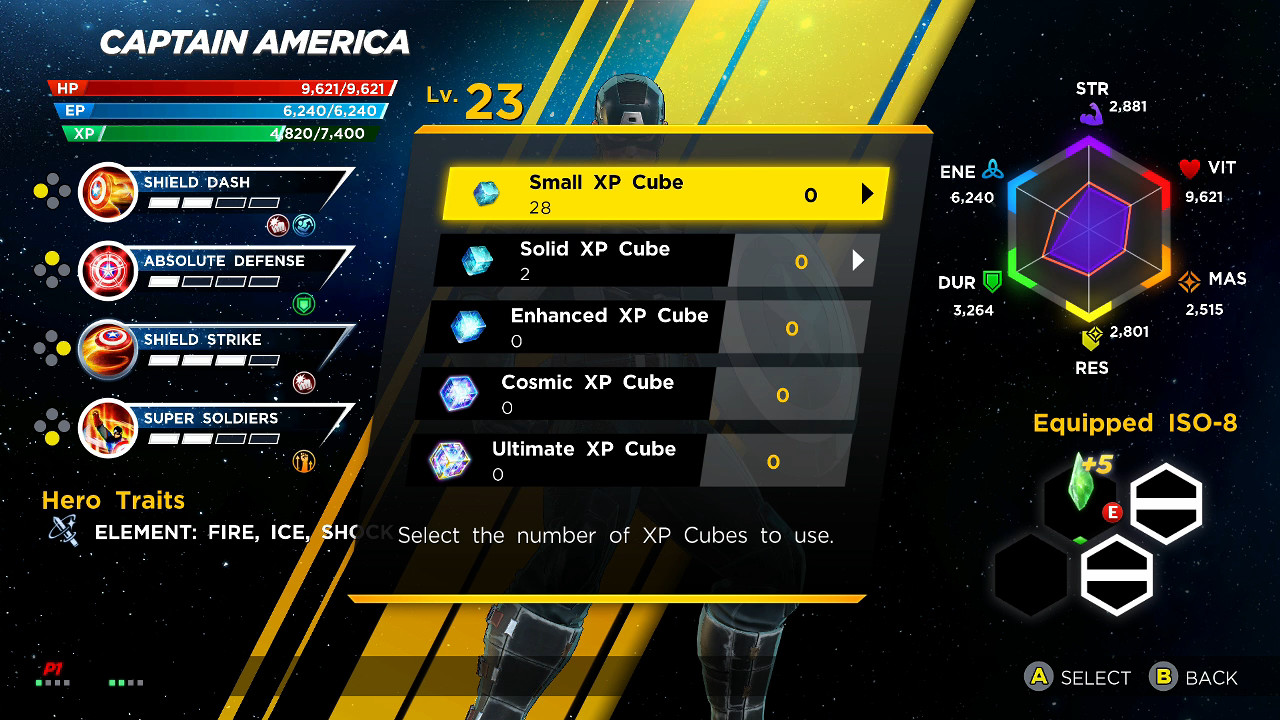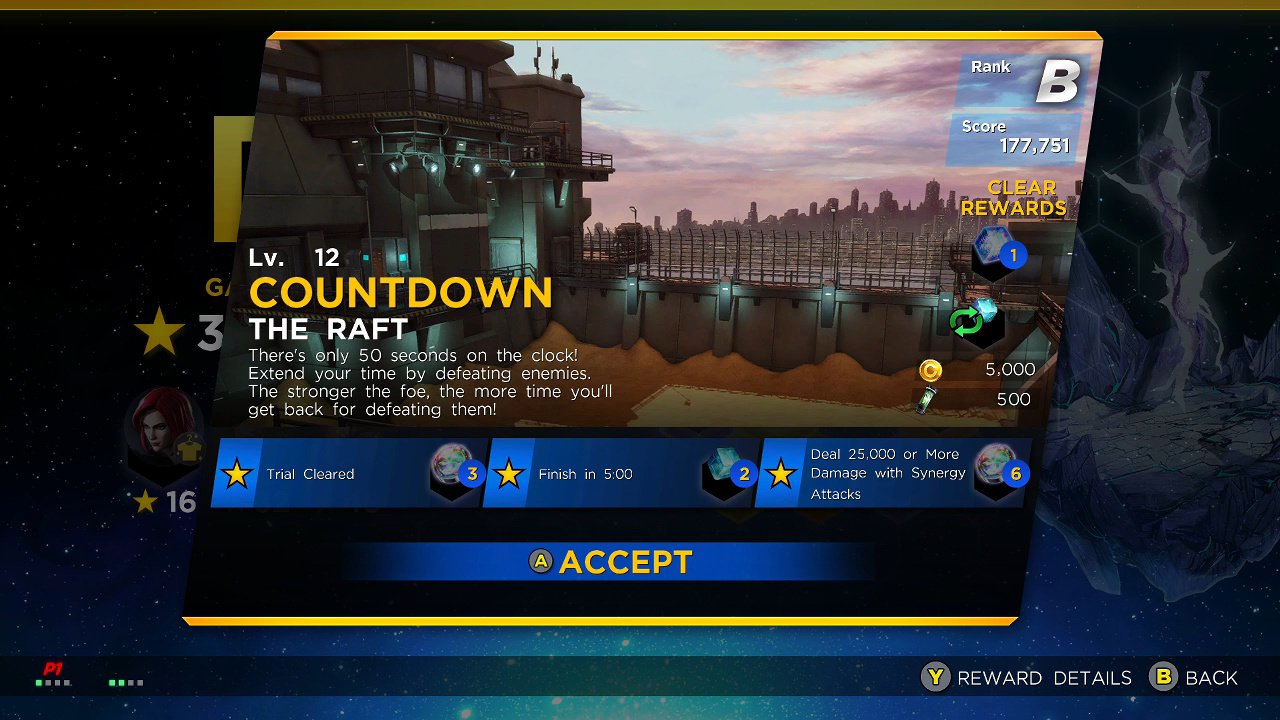After 11 years, the Marvel Ultimate Alliance series has a new entry with Marvel Ultimate Alliance 3: The Black Order. It's a game that feels like a modern take on the button-mashing, isometric, action-RPG (aRPG), even if it's not always entirely sure what that "take" should be.
First, a quick disclaimer. Our Co-Op FAQ covers some of the various systems/mechanics within Marvel Ultimate Alliance 3 (MUA 3) - such as the character stats, team bonuses, etc. - in more depth, as well as going through the different co-op configurations the game supports. I'll discuss these elements where something is particularly noteworthy (good or bad), so it's worth checking that article out for more information about those topics. Playing the game cooperatively, which is fun and definitely the way to go, doesn’t change the core gameplay in any meaningful way, i.e., whether you’ve got a buddy or not you’ll be running around levels, beating up enemies, getting experience, and collecting loot. I’ll be discussing the game as a whole before diving into a few specific co-op details.
MUA 3 starts off with the Guardians of the Galaxy team detecting some weird "cosmic energy" readings in what should be an empty piece of space, and before you can snap your fingers, you're off on an adventure to acquire all the Infinity Stones before Thanos does and destroys the universe. So as not to spoil anything, I'll just say that the somewhat simplistic/unsurprising story takes you on a tour of different recognizable locations from the Marvel universe (like The Raft and Xavier Institute). That's perfectly fine as the real meat of MUA 3, like any aRPG, lies within the two core gameplay mechanics: fighting enemies and looting.

Much like the previous Marvel Ultimate Alliance (and X-Men Legends) games, MUA 3 has its fair share of mindless, button-mashing action. Most of the enemies you encounter in the game can be taken out using some combination of the basic light and heavy attacks (as in, using a mix of the two; the only combo you have is hitting the light attack button a few times). Each playable character also has access (eventually) to four different special abilities, which more-or-less embody some iconic move for a particular character. For example, Iron Man has his "Unibeam" attack where he shoots a big laser out of his chest, Thor shoots thunder from Mjolnir, and Hulk... well, smashes. These abilities are good for taking out the rank-and-file, however their real utility comes from combining them into "Synergy Attacks". These attacks not only produce a greater effect of the two abilities (e.g., if Hulk and Thor both use "smash" attacks, then it causes an earthquake that temporarily stuns enemies), but they also have a strategic use: staggering foes.
Tougher enemies and bosses not only have more health, but they also have a purple "Stagger" gauge below their health bar, which means their attacks can't be interrupted until that gauge is drained. If you want an opportunity to deal damage to them, you'll need to deplete their Stagger gauge (using basic or special attacks), which will temporarily stun them - but this gauge will quickly begin to refill. To prolong their stunned state and increase the damage you do to them, you'll need to hit them with a Synergy Attack before the gauge refills. It may not be the most strategic gameplay mechanic to ever find its way into an aRPG, but it helps to break things up a bit. A few bosses also have special mechanics that require you to perform certain actions, like picking things up in the environment and throwing them at the boss, to bring down their Stagger gauge. Again, nothing earth-shattering (and one in particular is annoying), but at least it adds a little variety to the action. Your rewards for defeating these all of these foes are experience and the game's only form of loot: ISO-8 crystals.

As you earn experience for your characters, their overall stats will increase and they'll earn ability points that can be spent to level up their abilities (up to a max of level 4). At levels 10, 15, and 20, you'll unlock new abilities for your characters, and at levels 20 and 30 you'll unlock more slots where you can equip ISO-8 crystals. When equipped on a character, these crystals will provide straightforward boosts to a stat (e.g., 500 to Durability), a percentage boost to a stat ( 5.0% to Strength), or some other kind of boon (decrease the damage taken from melee attacks, or increases the damage of your light attacks).
Crystals vary on their grade (D to AA) and come in one of the six Infinity Gem colors, which relate directly to your characters’ stats. These crystals are what you'll be chasing as you play through the harder difficulties of the game as you look for the best versions with the best boosts possible. However, they are not the only source of passive bonuses. As you level up your roster of characters, you’ll earn Alliance Enhancement Points (AEPs). These can be spent in the Alliance Enhancement grid to unlock permanent stat boosts and other bonuses for all characters. Initially there is just one hex grid, but as you unlock more bonuses, you’ll open up six more grids (seven total) that will provide a variety of stat boosts and passive effects, such as increasing the damage of all melee attacks. Unlocking every bonus in one grid gives you a special bonus, like increasing the damage your characters do to a foe's Stagger gauge, and once you’ve unlocked all six of those special bonuses, you’ll get the final unlock: a fourth ISO-8 slot. While all of these boosts and boons apply to all your characters, getting them is quite the grind as the primary source of AEPs comes from leveling your characters, and that is no easy feat.
The process of earning experience in order to level up characters in MUA 3 just about kills all the fun of the game. With any aRPG there’s an expectation that you’ll be playing the same levels/missions over and over in order to gain experience and loot (aka, “grinding”), but in this case it’s a bit too much. Any character that is not in your team does not receive any experience, which means you’re only leveling four out of a roster of 36 playable characters at a time. What’s more, enemies appear to give you the same amount of experience regardless of the difficulty level or their level compared to your character’s level (i.e., bringing a low level character into a higher level fight doesn’t get them any more experience than in a lower level fight).
So, if you’ve been playing with a group of characters for a while and want to change things up, you’re going to have to jump back a few campaign missions to fight enemies that are around the same level as those characters and repeat content you just cleared. This is where things get a little tricky. Outside of a few specific cases (more on those in just a second), you do not need to level up all 36 playable characters in order to progress through the campaign. If you want to stick with the initial Guardians team and play all the way through, you absolutely can.

The tricky bit is that you’re going to want to change up who you’re playing, either because you’re bored of your group, you just unlocked a new character and need a new group that synergizes with them better, or (and this is the more important one) you need more AEPs to buy more buffs for your characters. As stated previously, the only way to consistently earn AEPs is by leveling characters, and getting AEPs/buying buffs in the Alliance Enhancement Grid becomes particularly important as you tackle the harder difficulty levels. The one bit of good news here is that there are two alternatives to replaying the same story content over and over, but they’re not exactly great either. The first is that you’ll occasionally earn “XP Cubes” as you play which can be used to instantly give a character some experience. You’ll only earn enough of these in a campaign playthrough to level up one or two characters outside of your main squad, though.
The second alternative is to take on some Infinity Trials, which are challenges that are unlocked as you play. These are separate from the campaign but any experience or ISO-8s you earn will carry back into your campaign playthrough. Some Trials set you with a task (defeat three bosses) and some modifier (abilities/Synergy Attacks do more damage, all other damage is decreased), but others are more straightforward (defeat 200 enemies). There are also about a dozen “Solo” challenges that require a specific character (such as Star Lord) at a minimum character level in order to tackle/clear the challenge. These are fun and a nice break from the campaign, but they’re also just another form of repetition. The second or third time you do a Trial with a mix of high and low level characters to try and level them up, you really begin to feel the mind-numbing repetition of combat encounters: clear out red bar enemies, wear down tougher foes’ Stagger gauge, use a Synergy attack to stun, and then pile on the damage. You’ll also start to see more flaws in this combat system, which is the one place MUA 3 really needed to shine to help make the grind feel like less of a chore.

Using your light and heavy attacks lock you into a combat animation and if an enemy attacks you during this, you’re going to get hit at least once. Usually it’s multiple times as enemies have their own attack combos. While there is a dodge/guard move to help you decrease or completely avoid the damage you would take, if you don’t time it right or if you’re in the middle of an attack animation, you’ll get locked into taking those multiple hits without a way to mitigate that damage. To make matters even worse, enemies will attack from off-camera so even if you’re playing carefully, you’ll occasionally get sucker punched by a foe you didn’t even know was there. This is where the Team Ninja approach to the combat in aRPGs (i.e., dodging/blocking enemy attacks and then countering with your own moves) feels like it directly butts heads with the Koei Tecmo approach (mash those buttons and watch your enemies fall before you in massive piles). MUA 3 can’t decide which approach it wants to use and it never finds a good middle-ground. Playing with friends definitely helps break up all this monotony, but co-op also has its downsides.
MUA 3 supports a lot of ways to play with friends (couch co-op, online co-op, WLAN, and combo), and it allows online/WLAN players to use their own characters when playing with friends and keep any progress (including story/campaign progress, experience earned, and ISO-8s acquired) when they go back to their own game. There are two issues when playing cooperatively: leveling and lack of character customization. The first is a bigger problem. If you join an online or WLAN game, you’re only bringing one character into the active party while the host will fill all empty slots with characters from their roster. If it’s just you and a buddy playing, this means you’ll be leveling one hero while your buddy gets to level three. This only exacerbates the existing grind problem mentioned previously as you’ll end up with one really high level character and a bunch of lower level ones that you’ll have to level up separately (or swap hosting duties with your buddy).
The second is less important, but still worth noting. Every Captain America is pretty much the same. You and your buddy will have the same abilities, the same moves, and just about the same look as unlockable outfits are just palette swaps; no “Civil War” version of Cap, or “Silver Age” style. The only differences will be what ISO-8s you have equipped, but as these have no cosmetic impact, it doesn’t “feel” like much of a difference, which matters because it’s hard to discount that feeling when you hop into a friend’s game and get asked, “where did you get that [outfit/piece of gear]?!” or “what build are you using?”
Marvel Ultimate Alliance 3 gets so close to being the kind of aRPG I’ve been craving since Marvel Heroes Omega got shutdown. It has a wide roster of Marvel characters with which you can play, you battle a variety of notable supervillains in some well-known settings, and the special ability/synergy moves are the kinds of moves you want to see (e.g., Iron Man blasting his unibeam into Cap’s shield). However, all these cool style elements don’t make up for the fact that as an aRPG, MUA 3 is very middle of the road. The grind is real and significant, the combat (which should make the grind feel more fun) becomes repetitive and frustrating at times, and the loot (which should give you some visual sense of progression) is lackluster. MUA 3 can have its fun moments, particularly in co-op, and it will certainly provide you with a lot of “game to play,” but after your initial playthrough, it’s best to relegate this to that selection of games you idly play while on a long car ride, watching TV, or listening to a podcast.
Verdict
Co-Op Score
Overall
The Co-Op Experience: Team up with three friends locally on the same Switch (couch co-op), connected to three other Switch systems via WLAN, or online. Drop-in/drop-out co-op is supported throughout the campaign for couch co-op only. Players choose from a variety of Super Heroes from the Marvel Universe. Co-op is also supported in the "Infinity Trials" mode that unlocks after reaching a certain point in the campaign. Combo Co-Op (i.e., a combination of couch, online, or local wireless co-op) is supported in the following configurations: Couch and Online (max 4 players) - two or more players on a single Switch can join another player (or group of players) online. The maximum number of players allowed is 4. For example, two players on one Switch (couch co-op) could setup or join an online game with two other players on a Switch (or two players on two separate Switches). Couch and Local Wireless (max 4 players) - two or more players on a single Switch can join other players via a local wireless connection. The maximum number of players allowed is 4. NOTE: A Nintendo Switch Online membership is required to play this game online with friends.
Co-Optimus game reviews focus on the cooperative experience of a game, our final score graphic represents this experience along with an average score for the game overall. For an explanation of our scores please check our Review Score Explanation Guide.
